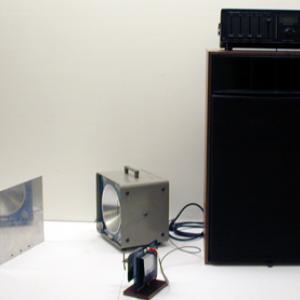College of Liberal Arts & Sciences
5N10.55 - Electromagnetic Radiation - Microwave
See also 9B65.91 in Facilities Support.
Video Credit: Jonathan M. Sullivan-Wood
Connect the receiver to the amplifier. This will make the reception audible. The characteristics of a dipole transmitter and receiver can be explored.
- Wathiq Abdul-Razzaq, "Cell Phone RF Radiation", TPT, Vol. 53, #4, Apr. 2015, p. 236.
- Marta Rojo and Juan Munoz, "'Hearing' Electromagnetic Waves", TPT, Vol. 52, #9. Dec. 2014, p. 554.
- Glenn S. Smith, "Teaching Antenna Reception and Scattering from a Time-Domain Perspective", AJP, Vol. 70, #8, Aug. 2002, p. 829.
- Glenn S. Smith, "Teaching Antenna Radiation from a Time-Domain Perspective", AJP, Vol. 69, #3, Mar. 2001, p. 288.
- R. T. Bush, "The Antenna Formula: An Application of Single-Slit Diffraction Theory", AJP, Vol. 55, #4, Apr. 1987, p. 350.
- Martin A. Uman, D. Kenneth McLain, and P. Philip Krider, "The Electromagnetic Radiation from a Finite Antenna", AJP, Vol. 43, #1, Jan. 1975, p. 33.
- O-030: "Microwaves", DICK and RAE Physics Demo Notebook.
- "October 8, 1945: First Patent for the Microwave", APS News, Vol. 24, #9, Oct. 2015, p. 2.
- Jearl Walker, "4.48, Heating in a Microwave Oven", The Flying Circus of Physics Ed. 2, p. 197.
- Kevin Dupzyk, "Disassembly Report: Microwave Oven", Popular Mechanics, Sept. 2016, p. 24.
- W. Bolton, "Standing Microwaves", Book 2 - Waves and Particles, Physics Experiments and Projects, 1968, p. 15.
- W. Bolton, "Reflection and Refraction of Microwaves", Book 2 - Waves and Particles, Physics Experiments and Projects, 1968, p. 16.
Disclaimer: These demonstrations are provided only for illustrative use by persons affiliated with The University of Iowa and only under the direction of a trained instructor or physicist. The University of Iowa is not responsible for demonstrations performed by those using their own equipment or who choose to use this reference material for their own purpose. The demonstrations included here are within the public domain and can be found in materials contained in libraries, bookstores, and through electronic sources. Performing all or any portion of any of these demonstrations, with or without revisions not depicted here entails inherent risks. These risks include, without limitation, bodily injury (and possibly death), including risks to health that may be temporary or permanent and that may exacerbate a pre-existing medical condition; and property loss or damage. Anyone performing any part of these demonstrations, even with revisions, knowingly and voluntarily assumes all risks associated with them.

